How to plant potatoes correctly, a description of the best ways to sow potatoes
Potatoes are cultivated in different climatic zones. To adapt to the conditions of their region, gardeners and vegetable growers have invented many methods of planting and growing vegetables. The correct method will provide an increased yield and justify the efforts made. So, we will tell you in detail when and how to plant potatoes correctly.
The content of the article
When to plant potatoes
Potatoes are an early planting crop. The most correct time is considered to be the days when the snow has completely melted, but the ground is still wet. This is especially important for non-irrigated areas.
The peak of potato planting is in early - mid-May. The ground is already warm enough, and frost is unlikely. But in each climatic zone, the timing depends on the characteristics of the weather. In the southern regions, planting begins in late April, in colder regions - in late May - early June.
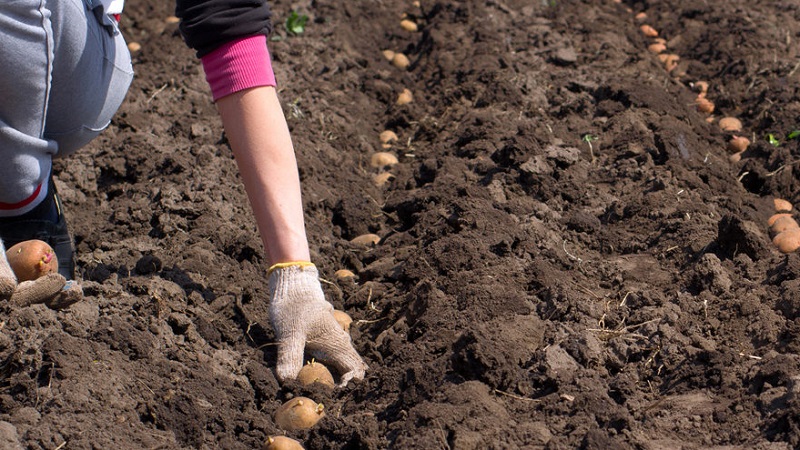
Early varieties
To obtain an early harvest, early ripening varieties are used. The average ripening period is 60-70 days, but the ultra-early ones are removed after 35-50 days.
The varieties have proven themselves well Red Scarlett, Kamensky, Elizabeth, Gala, Timo.
Important! When choosing a potato variety, its adaptation to the conditions of a particular region of the country must be taken into account.
In the southern regions, early ripening varieties are planted at the end of March - April for the first harvest. In the central regions, the date is shifted to the warm end of April - early May.
Late varieties
Late varieties vegetate for more than four months, and the tuber is formed in 110-115 days. They are more in demand in farms, as they show high yields and are stored for a long time.
Most Popular: Belorussky-3, Synthesis, Atlant, Zarnitsa, Picasso.
In the south of the country, late potatoes are planted in early April. In the middle lane, the period falls on the first days of May.
How to choose a place and prepare the soil for planting
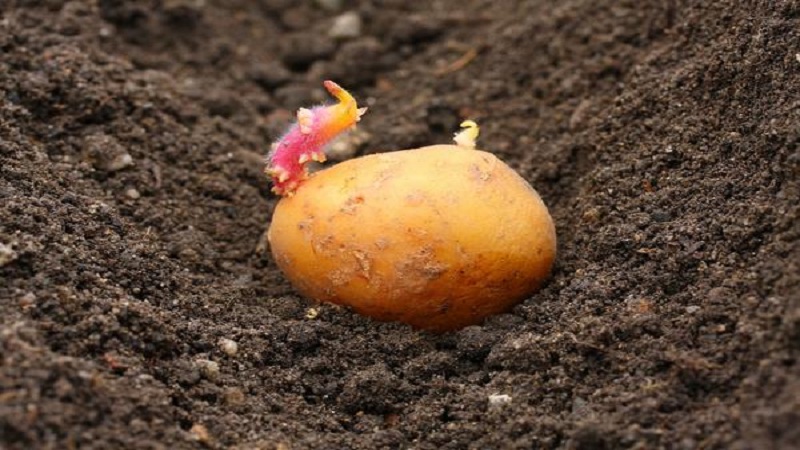
A site for potatoes is chosen well-lit, with protection from weathering. The soil is preferably loose and light, sandy loam, loam and forest soils are suitable.
Attention! It is impossible to cultivate a vegetable in one place for several years in a row. Pathogens and pests remain in the beds and will certainly damage the plants.
Observance of crop rotation is more effective and beneficial for the harvest than the annual application of organic matter and mineral fertilizers. The best predecessors are cabbage, onions, legumes, cucumbers and corn. Potatoes show good results on virgin lands.
The beds for planting are prepared in the fall. In early October, the land is plowed or dug up to a loose state and fertilized. Plowing is done without moldboard, no more than 30-35 cm in depth. This excludes mixing of the upper humus layer with the lower podzolic layer.
Filling with fresh manure works well before winter; in the spring, only rotted manure is used. As a prophylaxis against the Colorado potato beetle per 1 sq. m scatter a few pinches of ash and urea.
Each type of land requires specific training:
- Clay and heavy soil is loosened with sand, rotted straw, lime, turf soil.
- Sandy is enriched with peat, well-rotted organic matter and fast-acting mineral compositions.
- Clay flour, sand and compost are applied to peat bog areas for structuring.
- Compost, peat, and some mineral compounds are added to sandy stones.
- Acidic soils neutralized with ash or lime in the amount of 1-2 kg per 1 sq. m.
- For loams and medium-sized lands, a bucket of manure and compost is enough per garden bed.
At what temperature does potatoes grow
Planting potatoes begins when the ground warms up to + 9 ° C by 8-12 cm in depth. Ideal conditions for growth are air temperature + 15… + 22 ° C, humidity 75-80%.
Many gardeners are afraid of late frosts. But in most cases, damaged shoots are restored at the expense of the underground part, and the upper dry layer of the earth does not have time to freeze.
How to plant potatoes correctly to get a good harvest
Selection and pre-planting of potatoes is one of the key factors in ensuring an increased yield. Healthy tubers without damage, 5-6 cm in size and weighing 50-80 g, are chosen for seed.
Germination speeds up the emergence of seedlings. There are several ways:
- The tubers are kept in the light for 2-3 weeks at a temperature of + 12 ... + 15 ° C.
- In a wet substrate (peat, sawdust) with a layer thickness of 5-7 cm for 20 days.
- In plastic bags, 12 pcs. in everyone. Several holes are made and hung near a shaded window or fence for three weeks.
- In a greenhouse, potatoes are laid out on a thick layer of hay and covered with a film with vents on the sides for 12-15 days.
Potato consumption per hundred square meters depends on the method and density of planting. The optimal amount is 25-30 kg, the minimum is 20 kg. With an average tuber weight of 50 g, about 500 tubers (25 kg) are consumed per hundred square meters. The holes are made every 30 cm. The planting density depends on the size of the tubers.
Important! The strongest bushes grow from tubers, in which, by the time of planting, the rudiments of roots have also developed.
Manually
Gardeners traditionally plant potatoes by hand, using garden tools and simple tools. The method is chosen taking into account the condition of the land, the level of groundwater and the size of the site.
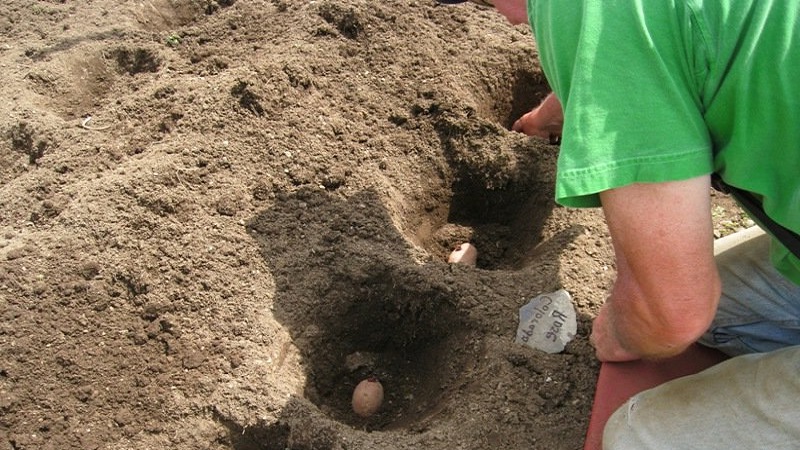
Shovel landing
Landing with a shovel is a basic "old-fashioned" option, but the most justified on light soils with low water occurrence.
Future beds are planned with pegs and twine. On a pre-dug area, every 27-30 cm, make holes 6-10 cm deep and lay out the tubers. A handful of humus or compost is thrown on top and covered with earth. Row spacing - 65-70 cm.
Landing in ridges
The principle of the method in replacing holes with shallow grooves:
- A rope stretched along the site marks the direction of the furrows. Grooves are formed into which the tubers are laid out at a certain interval.
- With a rake, the earth is poured back from both sides.
- Retreat 60-70 cm and repeat the steps.
This method is also used for double rows. Between adjacent ridges, the distance is made 20-30 cm, and the row spacing is increased to 90-110 cm.
Important! For clayey moist soils, these two methods are not suitable. There is a high probability of rotting sprouts and the appearance of fusarium.
Trench beds
The method of planting in trenches is considered to increase the yield and fertility of the site. In hot climates, the tubers and soil in such beds do not dry out. On sandy soils, potatoes will get more moisture.
Trenches for next year are being prepared in the fall:
- Mark the location of the rows and dig trenches on the shovel bayonet. The earth is laid on one side.
- The bottom is covered with plant remains, fallen leaves and sprinkled with earth.
- In the spring, they again add a little soil to the trench from the top of the ridges, dust it with ash, lay out the potatoes and sprinkle it with earth.
- As the sprouts appear, the planting is spud.
Ridge landing
In areas with coarse clay soil, where there is constant moisture due to high water table, the ridge method is very effective and therefore preferred.
Operating procedure:
- In autumn or spring, the site is plowed with a motor-cultivator, while mineral fertilizers are applied.
- Ridges are formed with a height of 13-15 cm and a width of 50 cm with a row spacing of 60-70 cm.
- In the middle of the elevation, holes are made and tubers are covered.
The larger the tubers, the deeper they are planted.
Using a walk-behind tractor
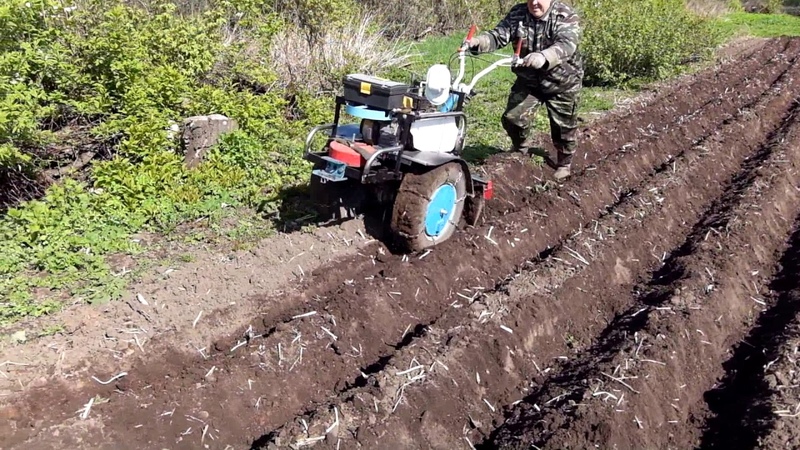
Using a walk-behind tractor for planting potatoes makes the process easier. This method is used on all types of soil. It is subdivided into several ways.
Under the plow
Potatoes are planted together. One person makes a straight furrow with a walk-behind tractor so that the plow goes to the depth of a bayonet shovel. The second one follows and lays down the tubers with a distance of 25-30 cm. On the way back, another row is made, and the previous one is covered with earth from the plowed furrow.
With the help of a hiller
First, the furrows are cut and the potatoes are laid out. On the walk-behind tractor, the lugs are changed to ordinary rubber ones and the hiller is attached. When re-passing through the rows, he fills them with earth and ramps them with plates.
Potato planter
This method requires the purchase of a hinged potato planters... It pays off for large-scale crops and speeds up work significantly. In one pass, the device makes furrows, lowers the tuber into the ground, and the disc hiller fills the hole. Grousers are put on the wheels.

How to sow potatoes
Growing potatoes from seeds is a laborious process. The potatoes for food will only be received in two years.
Planting material is properly collected and prepared:
- In August, large berries are cut from the bush.
- Wrapped in gauze or cloth bag and left to ripen on the windowsill.
- When the berries are soft, pick all the seeds.
- They are washed, dried and sent in a bag to a dark place until spring.
In early March, the seeds are soaked in a dense, damp cloth until the sprouts hatch. A universal soil is poured into a container for seedlings with a layer of 5-7 cm and seeds are covered. Well moistened from a spray bottle, covered with a film and put in a lighted place.
When 1-2 true leaves appear on the seedlings, the seedlings are dived into cups. When transplanting, they are fed with liquid organo-mineral fertilizer for seedlings ("Biohumus", "Ideal", "Krepysh"). Seedlings are planted in open ground at the end of May, when the threat of frost has passed. The wells are made 10 cm deep, 200 g of humus are poured into each.
For the first time, small tubers weighing 10-50 g will be obtained. In the next 2-4 years they will produce elite potatoes with high quality indicators.
How to care for planted potatoes
After planting, potato care aims to create optimal growing conditions and control pests.
Loosening
At the end of the work, the first thing to do is loosen the trampled earth. At the same time, the first weeds are destroyed and soil aeration is improved. Before the first shoots, they are harrowed a week after planting. In order not to accidentally touch the tubers, the tool is held diagonally to the beds.
Frost protection
Even at the end of May, frosts sometimes occur. Before the expected drop in temperature, 3-5 cm of soil is scooped up for seedlings. If this is not done, the tubers will not freeze and give new shoots, but the yield will decrease slightly.
Hilling
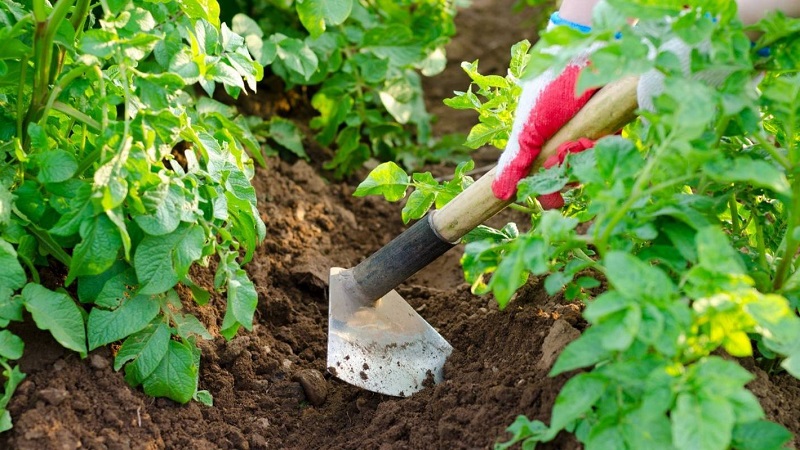
Hilling - an obligatory step in caring for a vegetable. Wet soil is raked from the edge of the row to the center of the bush.
Hilling solves several problems:
- protects against frost;
- stimulates the growth and formation of tubers;
- the soil is additionally loosened with the accompanying destruction of weeds;
- simplifies harvesting.
The first time is spud at a height of shoots of 5-10 cm. They pass again before opening the buds and again - during flowering.
Watering
Newly planted beds are watered on very dry soil. When the sprouts reach 10-12 cm, they begin to water warm water from a tank at the rate of 3-4 liters to the center of the bush. During the period of tuber formation, the consumption is increased to 20 liters per bush.
Top dressing of potatoes
Potatoes are responsive to the introduction of organic matter and mineral fertilizers.When the first shoots appear, a solution is prepared from 30 g of urea and 10 liters of water. Pour 0.5 liters of liquid into the center of each bush. Poultry droppings also stimulate vegetation well. It is diluted to a mushy state, then 0.5 l of the substance is dissolved in 10 liters of water. The plant takes about 400-500 g of organic matter.
Pest control
Colorado potato beetle larvae are simply destroyed along with the leaf. Adult insects are collected by hand or sprayed with a suitable insecticide.
The most popular preparations among vegetable growers are: "Colorado", "Aktara", "Confidor Extra", "Karate". If signs of damage to the tops are detected, they are promptly treated with a chemical according to the instructions. Repeat after 10-14 days to consolidate the result.
Conclusion
The way potatoes are planted directly affects the yield. Each method is aimed at providing a comfortable environment for plant development and growth. Pre-planting preparation accelerates the maturation of tubers. Adult bushes need periodic moderate watering, feeding and protection from pests.